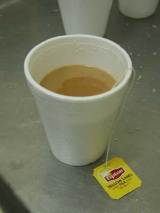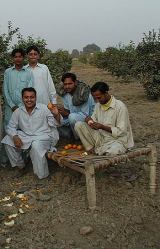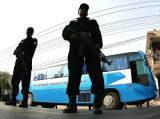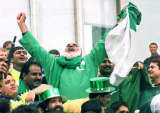Sunday November 13

|

'Take one mug, add three heaped sugars, two heaped powdered milks, one
tea-bag (belatedly) - and if there's any room left after that, add water
to taste'
© Andrew Miller
|
|
They don't do things by halves in Pakistan. Whether it's overtaking a
donkey cart on a blind corner, rallying the Multan constabulary to escort
the team to a restaurant downtown, or delivering a paddyfield of rice to
go with your Jalfrezi once you get there, there's only one way to go and
that's completely over the top.
Take the humble cup of tea for instance. Now there is nothing in the world
I like better than a nice cup of tea and a sit-down. And in South Asia
that truth is so true you could hang a double-negative on it and call it a
NAND gate. For starters, it is hotter over here, so you need to take
things more slowly. But more importantly, the tea is quite simply
superior.
I've been trying to pinpoint exactly why that should be. Maybe it's just a
deeper, more aromatic infusion, quite unlike the
toenail-clippings-in-a-muslin-bag you get served up back home in England.
Maybe it's the preference for hot milk, which gives the end product a
thick hot-chocolately texture. Or maybe it's the sugar - which is thick
and grey and granular, and deliciously squeezed direct from the cane it
was growing in. In England I never have tea with sugar, over here I simply
can't have it without.
Not that my selective sweet-tooth is entirely through choice, mind you.
Because short of claiming that you don't like cricket, there is only one
other thing that is sure to leave your hosts wide-eyed with incredulity -
and that is saying that you don't like sugar. Chaiwallahs take it as a
personal sleight, a mortal insult to generations of tea-making skills, and frankly,
in my years of contented research into the subject, I am more than happy
to surrender to their superior knowhow. If you want to sup a super cuppa,
come to Pakistan.
Don't, however, assume that everyone who touches your tea-bag is blessed
with the same skills. The tirelessly helpful staff of the Pakistan Cricket
Board, to pluck a random example, aren't quite so well-versed in the art.
It is frightening to envisage how many teetering towers of polystyrene
mugs they must get through in a day, but their formula is always the same
- take one mug, add three heaped sugars, two heaped powdered milks, one
tea-bag (belatedly) - and if there's any room left after that, add water
to taste.
The end result is a viscous saccharine soup, only recognisable as tea
thanks to the helpful yellow tag dangling over the edge. Still, it keeps
you awake alright - although that's largely because your teeth start
screaming for mercy after half a cup. I find it safer to insist on adding
my own condiments, for all the strange looks that entails.
Saturday November 12

|

Everyone loves a freebie: '70 percent of the seats were absolutely scot-free' at Multan on Saturday
© Getty Images
|
|
There is a banner across the road to the stadium, proclaiming the legend:
"Welcome Cricket Teem". The first day at the stadium was not so much a
teem as a trickle, although to be fair it was a steady one nonetheless.
Before too long the stands were considerably more populated than they had
been 18 months earlier, when Virender Sehwag's triple-century was greeted
by a cacophony of indifference and a thousand yawning policemen.
The PCB's ticketing policy had quite a hand in this increased interest,
mind you - 70 percent of the seats were absolutely scot-free. Everyone
loves a freebie, you see, and though the fever pitch on the bleachers was
not quite as frenetic as we can expect to see come the one-dayers, it was
a good-natured hubbub, with Chacha Pakistan easily visible in the Hanif
Mohammad enclosure - not so much for his stand-out Shalwar Kameez
(sponsored by Asian Washing Machines) - but for the reverberating throng
that was bouncing in unison around him.
By the morning drinks break, the writing was on the porcelain for England,
as four of their players scamper for the loo, and before long it was on the
TV screens as well, as the scorecard of Multan's last Test flashed up.
It didn't make encouraging reading for England: 675 played 407 played 216 all
out, Anil Kumble 6 for 72. The general consensus around the stadium was that it wasn't a toss to lose.
Around the edge of the pitch, a series of mysterious advertising hoardings
appeared. "Good luck Ian" they stated, in bold white letters on a red
background. Did Warwickshire pull a few PCB strings via their old
mucker, Bob Woolmer, and secure some prime advertising slots to cheer up
their beleaguered young batsman, Ian Bell? It turns out the signs were
there for the benefit of Ian Botham and his latest charity walk, but I'm
sure Belly appreciated the sentiments nonetheless.
By the close of play, however, a transformation in fortunes had taken
place. England's bowlers seized the initiative, and such is the
despondency in Pakistan's quarters that the post-match press conference
underneath the pavilion sightscreen did not, as widely predicted, descend
into a shambles. Shaun Udal faced a largely familiar set of faces,
crouched at his feet to allow the TV cameras to shoot straight over their
heads, instead of the stampede of hacks who swarmed around Trescothick on
the eve of the Test.
Back at the team hotel, there was yet more crouching taking place, as
representatives from every corner of the English contingent cram into the
restaurant of the Holiday Inn, to watch yet another Test triumph over the
Aussies. This time the sport was rugby, and once again, the result was
gleefully received by everyone from Botham (perched imposingly at the
table nearest the screen) to Kirk Russell the physio (centre right), to
Cricinfo's man in Multan (late on the scene, and quickly sent scurrying to
the back of the room after an abortive attempt to squeeze in dead-centre).
That's seven Test defeats in a row for the Wallabies, incidentally. Not
that it is of any relevance to this series whatsoever, but - diligent
sports journalist that I am - I just thought I ought to mention it ...
Friday November 11

|

Picking the seam: Workers relax on a charpai, while testing the oranges for ripeness
© Getty Images
|
|
Geoffrey Boycott once said of Wasim Akram and Waqar Younis that they could have bowled England out with an orange. It is just as well, for the egos of the batsmen concerned, that they never had the opportunity to take on the two Ws in Multan. For the Multan Cricket Association Stadium, the city's most state-of-the-art construction since the mighty Qasim Bagh fort, is situated right next to a sprawling orange grove, where contented workers test their produce for ripeness while idling on a string-crossed bed frame.
Multan's origins are so hazy that it is hard to pinpoint when exactly it was founded. Its glory days came under the Mughals in the 16th to 18th Centuries, although some believe it to be the oldest city in the subcontinent, dating back to 2000BC. The stadium itself, however, is a feast of modernity in an arid rural outcrop of the town. A faultlessly modern structure with roofs above even the cheapest of seats in the bleachers, it lies at the end of a wide sweeping presidential driveway, which can only have been designed with the arrival of an international cricket team in mind.
As with all the best motorcades, you heard the arrival before you saw it. The policemen attending to the traffic at the stadium junction became that little bit more urgent with their lathis, whipping impudent bicyclists into the verges to make way for the cortege, while sharp-shooters braced
themselves on the broken farm walls that lined the route.
And then came the whoop of sirens and the screech of tyres, as a Wacky Races convoy came hurtling round the bend and down the final straight. Two outriders on motorcycles setting the pace, and a flashy police range-rover providing the red and blue effects lighting.

|

England's practice session passes in a blur of uneventfulness
© Getty Images
|
|
Next a more conventional blue plod-mobile, ahead of the team bus itself, with Jimmy Anderson peeping through the curtains wondering what all the fuss was about. The journalists' mini-bus came next, followed by another police van, and to top the whole procession off, a bright red and
magnificently ancient fire engine, dredged from the depths of the Multan Municipal Corporation.
England's practice passes in a blur of uneventfulness, for the only contest on preview day is the fight to obtain the best seats in the press box. But the rickshaw journey home is a splendid buzz through the backstreets of Multan, now softly lit by a fading sun. Donkeys, donkeys everywhere, telegraphing their desperate world-weary gloom through the medium of ear semaphore. Some hung so low around their cheekbones that one half expected to look to the rooftops and find their tails being used as a door-knocker. Another, meanwhile, was such a picture of modesty that I
swear I saw it wearing a veil.
The buzz and bustle of Multan is of a more gentle, provincial, variety to the glam and glitz telegraphed by the streets of Lahore, or the thrusting urgency of Rawalpindi. It is not hard to work out where Inzamam-ul-Haq, the most famous Multani in existence, cultivated his gloriously dozy
persona. But if rivers run deep with Inzy, then so it is with his hometown, and shortly before sunset, a snapshot of what lies beneath is revealed in a shortcut, as we weave through the narrow clay-lined curves of the old city, watching uninvestigated alleys whizz by at every stroke.
Thursday November 10
After 24 hours, Multan already feels like a great leveller. There's no point getting hot under the collar in these parts, firstly because its warm enough already, and secondly because it's so much easier to stay cool. Yesterday morning, for instance, there appeared to be a city-wide
embargo on hot water - not only in the grandly underwhelming "Royal Continental Guest House" (where such things, I get the impression, are all too commonplace), but also in the flashier environs of the Holiday Inn, Multan's one and only five-star hotel.
I use the term advisedly, because there are five-star hotels and five-star hotels. England's previous two pads - the Pearl Continental in Lahore and the Marriott in Islamabad - represent the very top end of this particular scale, establishments so grand that they've installed their very own
airport-style x-ray machines in their oversized foyers; cockerel-crested doormen in ceremonial dress implore you, in their best and most ingratiating manner, to deign to this most tiresome of modern-day rituals.
For all that, there's something sadly antiseptic about such places. There's only so many times you can cope with a bastardised version of Elton John's "Can you Feel the Love Tonight?", for instance, as it floats with pan-piped evilness through every lift and eatery in the area. And I
have never yet managed to take two steps through the shopping mall without being accosted by some unctuous salesman in a trinket shop, mistaking a passing interest with a sale waiting to happen.
The Holiday Inn in Multan, however, is something entirely different. It has no grand sweeping driveway for the team bus to offload its precious cargo, so they've cordoned off the entire street outside. There's no room for an x-ray machine, so they've installed a walkthrough metal detector
which most people walk straight past. And there's no pipe for the musak to flow through, so they've resorted to one man and his Yamaha keyboard, who sits behind a pillar and fills the air with a funky electropop beat.
It's an oddly magnetic setting, mind you, for the Holiday Inn draws vagrants in from all around the city and beyond. Two sets of international teams plus entourage isn't bad for starters, and then there's the big-hitters from Sky and the latecomers from Fleet Street, and the refugees from the second-best guest-house in town, which is affectionally known as "The Scheisse" to its inmates, for reasons best known to themselves.
There's no doubt where the action in town is, however. The "Royal Continental" is the place to be for all-night partying, seven days a week. It turns out my pad is situated right next door to the "Taj Mehel Marriage Club" and its all-weather marquee, which means that every night is yet
another big night. Upon arrival, the corridors are a raucous melee of over-excited children, rushing around in various states of semi-prepared smartness and banging on the door of the solitary gora and his malfunctioning phoneline. Just remember to leave me a slice of wedding cake.
Wednesday November 9

|

'Multan promises an entirely different challenge to England's cricketers'
© Getty Images
|
|
Until recently, the Korean car company Daewoo used to advertise on British television with the slogan "Dae-who?", the implication being, of course, that no self-respecting Volvo driver would ever have heard of these funny-named interlopers.
In Pakistan, however, Daewoo are a byword for the luxury coach travel industry. It is the only way to go, I have it insisted upon me from all quarters that I encounter, and being an impressionable sort, who am I to argue? And jolly nice they turn out to be too, in a sort of up market budget airline sort of a way. There is in-flight entertainment (which is more than EasyJet can manage) in the form of a rickety Lollywood comedy, and an air-hostess is always on hand to top up your cup of water, as it sits in a handy cup-of-water-holder attached to the seat in front.
The one thing the Daewoo coaches cannot overcome, however, is the turbulence. And the route from Lahore to Multan has plenty of that. For large tracts of the four-and-a-half-hour journey, the road is a bone-jarring boulder alley, although there is at least a welcome 15-minute break at the half-way point, in which the passengers totter as one around the forecourt of a petrol station, and sip soothing polystyrene mugs of tea.
The view from the window is brown and sun-baked. The few settlements through which we pass are anachronistically urban, with smart blue banks crammed into small shabby shacks, like financial hermit crabs. But the endless procession of donkey carts reveals the true nature of the region. This feels like the route into the Pakistani hinterland.
And Multan feels like the capital of the hinterland. It takes several minutes of incremental chaos before I realise we are on the outskirts of a major town. The traffic has got that little bit more frenetic, the housing that little more intense, but the bricks and rubble that are strewn across the highway are not exactly a giveaway. And, I note with amusement, for all the apparent aloofness and serenity of the Daewoo coaches, it isn't long before the driver has descended to the level of a two-bit rickshaw driver, tooting and swerving and braking with the best of them, as he fights for the best line with which to enter the city.
In the midst of our approach is one of the most incongruous roundabout markers imaginable, an Air Force fighter jet mounted on a plinth and surrounded by fruit carts and their accompanying fruit flies, providing mid-day shade to the pie-dogs of Multan and a sense of bemusement to everyone else. How did it get there? Presumably it must have belly flopped out of the sky. After the airs of Islamabad and the class of Lahore, already Multan promises an entirely different challenge to England's cricketers.
Tuesday November 8

|

Abdul 'Chacha Cricket' Jalil: Pakistan's Jimmy Saville
© Getty Images
|
|
A familiar foe arrived to undermine England's ambitions at Bagh-e-Jinnah today. It wasn't injury or complacency, or illness or indifference - although all four could arguably have played their part. It wasn't even Hasan Raza who, after nine years on the international scene, is finally becoming the sort of player that his 14-year-old frame once promised he
could be. Instead the most noticeable difference was an old man with a long white beard, and a deep green salwar kameez.
Abdul Jalil is the flag-bearing uber-supporter of Pakistan cricket. Though he has been watching international cricket ever since Colin Cowdrey's MCC team toured back in 1969, and making a noticeable din in that time as well, it wasn't until 1997 that he underwent his superhero-style transformation. It was as if he had walked into a nearby phone-booth,
stripped off his former life as an official in the Forestry department, and burst back into the light, a beacon of zealous green, henceforth to be known as "Chacha Cricket".
Chacha (or Uncle)'s mission is a simple one - to arrest the gradual seepage of interest that has been afflicting Pakistan Test audiences, and whip those supporters that do turn up into a frenzy of patriotic fervour. He completes his brief with remarkable and instant alacrity wherever he sets foot, and these days he gets everywhere. The Pakistan Cricket Board,
so overjoyed at his efforts, pay him a monthly salary of 10,000 rupees (100 pounds), and additional income floods in from sponsorship as well.
Even at a venue so steeped in colonial strictures as the Lahore Gymkhana ground, Chacha is soon working his magic. He gallivants up and down the bank of Pakistani fans who are peering over the railings, waves a crescent moon and the Union Jack side by side, and soon a raucous chorus of "Pakistan Zindabad" is making the tree-tops rustle. On the grassy
pitch-side itself, watching this show take place, is another white-haired legend of Pakistan cricket. Imtiaz Ahmed, the venerable former wicketkeeper, scored 209 on this very ground against New Zealand in 1955, back in the days when decorum was the watchword.
It is undeniable devotion that Chacha inspires, and it makes me wonder if the man they call Jimmy Saville will be making this trip. Jimmy, the tatty St-George's-Cross-bearing choirmaster of the Barmy Army, was a ubiquitous presence during last summer's Ashes, and indeed most tours that have preceded it. His finest hour came during the Trafalgar Square celebrations in September, when he got up on stage to lead 100,000 fans - and one inebriated cricket team - in a rousing chorus of "Everywhere we go ..." - before being sniffily dismissed, on behalf of the establishment, by the compere Mark Nicholas.
These men are two peas from a pod, give or take the odd cultural nuance - abstinence being one of them. Yet, the one has been embraced even onto the pay-roll of the national cricket board, while the other remains defiantly on the outer limits; known and acknowledged by the team who have never yet under-estimated the importance of travelling fans, but shunned by the media and hierarchy alike - probably due in no small part to the sheer banality of his chants. Even so, I hope he arrives out here, if only to see how he is received by Pakistan fans. Somehow I imagine that, if he can survive the absence of alcohol, he will finally locate his home from home.
Monday November 7

|

The first big story of the tour: Michael Vaughan's knee injury
© Getty Images
|
|
Degree by gradual degree, the tempo of this tour is inching up the scale. The ambient surroundings of the Lahore Gymkhana Club don't exactly imply that a major Test series is just around the corner, but the signs are all in place if you care to look closely enough.
The press tent is bulging under the bulk of a dozen extra faces, including most of the broadsheet big guns, plus one chap who's been dispatched on a reconnaisance mission by the BBC Sports Personality of the Year organisers - what on earth could that imply, we wonder? All that remains is for the Sky commentary team to jet in at the last minute and bag the best rooms at Multan's Holiday Inn, and then it really will be all systems go.
Bagh-e-Jinnah's grassy banks are filling out as well, as England's fans begin to congregate in Lahore ahead of their journey south on Thursday morning. At Rawalpindi last week, the local papers got in a tissy about an advance party of five hard-core supporters, with their banner headline: "The Barmy Army descends on Pakistan". By those standards they must think it's a full-scale coup d'etat now - the numbers have more than doubled,
the first official T-shirts have been sighted, and up to 60 in total are expected come the start of the first Test.
England, too, were pulling their preparations together, at least until Michael Vaughan collapsed at the crease to send the think-tank back to the drawing-board. The first indications of an increased intensity came during a particularly full-on workout at the PCB National Academy on the eve of this match, and though it is England's batting that has been coming under the microscope, the sight of Andrew Flintoff and Steve Harmison hurtling
in during this morning's session, bouncing and battering the Pakistan A tail as they extracted the final two wickets, was the surest sign yet that they had finally shaken off their jet-leg.
Vaughan's knee, however, was the all-consuming topic of the day, as the camera lenses watched his comings and goings with ghoulish intent - from his collapse at the crease, to his departure to hospital, to his eventual hobbling return to the pavilion. The press-tent was a hubbub of speculation, fuelled by off-the-record updates from the team management,
while Dr Peter Gregory - whose previous claim to fame on this tour was the legbreak that bowled Ian Bell in the nets - was suddenly holding court at the biggest press conference of the series to date.






